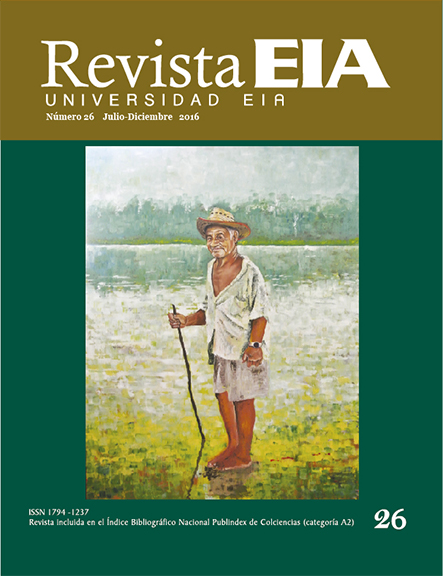PROPUESTA DE CALIBRACIÓN DE UN MODELO PARA EL TRÁNSITO DE CRECIENTES EN UN TRAMO DEL RÍO MEDELLÍN
PROPUESTA DE CALIBRACIÓN DE UN MODELO PARA EL TRÁNSITO DE CRECIENTES EN UN TRAMO DEL RÍO MEDELLÍN
Barra lateral del artículo
Términos de la licencia (VER)
Declaración del copyright
Los autores ceden en exclusiva a la Universidad EIA, con facultad de cesión a terceros, todos los derechos de explotación que deriven de los trabajos que sean aceptados para su publicación en la Revista EIA, así como en cualquier producto derivados de la misma y, en particular, los de reproducción, distribución, comunicación pública (incluida la puesta a disposición interactiva) y transformación (incluidas la adaptación, la modificación y, en su caso, la traducción), para todas las modalidades de explotación (a título enunciativo y no limitativo: en formato papel, electrónico, on-line, soporte informático o audiovisual, así como en cualquier otro formato, incluso con finalidad promocional o publicitaria y/o para la realización de productos derivados), para un ámbito territorial mundial y para toda la duración legal de los derechos prevista en el vigente texto difundido de la Ley de Propiedad Intelectual. Esta cesión la realizarán los autores sin derecho a ningún tipo de remuneración o indemnización.
La autorización conferida a la Revista EIA estará vigente a partir de la fecha en que se incluye en el volumen y número respectivo en el Sistema Open Journal Systems de la Revista EIA, así como en las diferentes bases e índices de datos en que se encuentra indexada la publicación.
Todos los contenidos de la Revista EIA, están publicados bajo la Licencia Creative Commons Atribución-NoComercial-NoDerivativa 4.0 Internacional
Licencia
![]()
Esta obra está bajo una Licencia Creative Commons Atribución-NoComercial-NoDerivativa 4.0 Internacional
Contenido principal del artículo
Resumen
En este artículo se presenta la metodología seguida en la calibración del modelo NWS-FLDWAV para el tránsito de crecientes en un tramo del río Medellín. Para la construcción del modelo se recopiló la información topográfica del tramo seleccionado del río y de las hidrógrafas de nivel registradas por las estaciones limnigráficas. A partir del análisis del comportamiento de las crecientes escogidas, se identificó la importancia de considerar los aportes de caudal a lo largo del tramo, los cuales surgen de la escorrentía directa causada principalmente por la precipitación. Se determinó una forma para calibrar el modelo a partir del coeficiente de rugosidad de Manning y del caudal de aporte en el tramo. Este caudal se obtuvo del análisis de la diferencia entre caudales base para las dos estaciones limnigráficas que limitan el tramo y se simuló con una distribución espacial y temporal.
Abstract: This paper presents the methodology used to calibrate an NWS-FLDWAV model for flood routing through a stretch of the Medellín river. To build the model, the topographic information of the selected river section was compiled as soon as the stage hydrographs registered in the gauge stations. The importance of considering the discharge contributions along the stretch, which arise from the direct run-off caused essentially by the precipitation, was identified through the analysis of the behavior of the chosen floods. A way to calibrate the model was discovered that included the Manning coefficient of frictional resistance and the contribution discharge. This discharge was obtained from the analysis of the difference between base discharges for the two measurement stations that limit the river segment and were simulated with a spatial and temporal distribution.


 PDF
PDF
 FLIP
FLIP